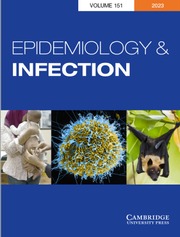Crossref Citations
This article has been cited by the following publications. This list is generated based on data provided by
Crossref.
Mucklow, Patrick T.
Vizoso, Dita B.
Jensen, Knut Helge
Refardt, Dominik
and
Ebert, Dieter
2004.
Variation in phenoloxidase activity and its relation to parasite resistance within and between populations of
Daphnia magna
.
Proceedings of the Royal Society of London. Series B: Biological Sciences,
Vol. 271,
Issue. 1544,
p.
1175.
Ebert, Dieter
Joachim Carius, Hans
Little, Tom
and
Decaestecker, Ellen
2004.
The Evolution of Virulence When Parasites Cause Host Castration and Gigantism.
The American Naturalist,
Vol. 164,
Issue. S5,
p.
S19.
Hall, Spencer R.
Duffy, Meghan A.
and
Cáceres, Carla E.
2005.
Selective Predation and Productivity Jointly Drive Complex Behavior in Host‐Parasite Systems.
The American Naturalist,
Vol. 165,
Issue. 1,
p.
70.
Decaestecker, Ellen
Declerck, Steven
De Meester, Luc
and
Ebert, Dieter
2005.
Ecological implications of parasites in natural Daphnia populations.
Oecologia,
Vol. 144,
Issue. 3,
p.
382.
Cáceres, C. E.
Hall, S. R.
Duffy, M. A.
Tessier, A. J.
Helmle, C.
and
MacIntyre, S.
2006.
PHYSICAL STRUCTURE OF LAKES CONSTRAINS EPIDEMICS INDAPHNIAPOPULATIONS.
Ecology,
Vol. 87,
Issue. 6,
p.
1438.
Hall, Spencer R.
Tessier, Alan J.
Duffy, Meghan A.
Huebner, Marianne
and
Cáceres, Carla E.
2006.
WARMER DOES NOT HAVE TO MEAN SICKER: TEMPERATURE AND PREDATORS CAN JOINTLY DRIVE TIMING OF EPIDEMICS.
Ecology,
Vol. 87,
Issue. 7,
p.
1684.
Duffy, Meghan A.
and
Sivars‐Becker, Lena
2007.
Rapid evolution and ecological host–parasite dynamics.
Ecology Letters,
Vol. 10,
Issue. 1,
p.
44.
Hall, Spencer R.
Sivars‐Becker, Lena
Becker, Claes
Duffy, Meghan A.
Tessier, Alan J.
and
Cáceres, Carla E.
2007.
Eating yourself sick: transmission of disease as a function of foraging ecology.
Ecology Letters,
Vol. 10,
Issue. 3,
p.
207.
Ebert, Dieter
Altermatt, Florian
and
Lass, Sandra
2007.
A short term benefit for outcrossing in a
Daphnia
metapopulation in relation to parasitism
.
Journal of The Royal Society Interface,
Vol. 4,
Issue. 16,
p.
777.
Pulkkinen, Katja
2007.
Microparasite transmission to Daphnia magna decreases in the presence of conspecifics.
Oecologia,
Vol. 154,
Issue. 1,
p.
45.
Ebert, Dieter
2008.
Host–parasite coevolution: Insights from the Daphnia–parasite model system.
Current Opinion in Microbiology,
Vol. 11,
Issue. 3,
p.
290.
Ben-Ami, Frida
Regoes, Roland R
and
Ebert, Dieter
2008.
A quantitative test of the relationship between parasite dose and infection probability across different host–parasite combinations.
Proceedings of the Royal Society B: Biological Sciences,
Vol. 275,
Issue. 1636,
p.
853.
Frost, Paul C.
Ebert, Dieter
and
Smith, Val H.
2008.
RESPONSES OF A BACTERIAL PATHOGEN TO PHOSPHORUS LIMITATION OF ITS AQUATIC INVERTEBRATE HOST.
Ecology,
Vol. 89,
Issue. 2,
p.
313.
FELS, D.
VIGNON, M.
and
KALTZ, O.
2008.
Ecological and genetic determinants of multiple infection and aggregation in a microbial host-parasite system.
Parasitology,
Vol. 135,
Issue. 12,
p.
1373.
Duffy, Meghan A.
and
Hall, Spencer R.
2008.
Selective Predation and Rapid Evolution Can Jointly Dampen Effects of Virulent Parasites on Daphnia Populations.
The American Naturalist,
Vol. 171,
Issue. 4,
p.
499.
Frost, Paul C.
Ebert, Dieter
and
Smith, Val H.
2008.
Bacterial infection changes the elemental composition of Daphnia magna.
Journal of Animal Ecology,
Vol. 77,
Issue. 6,
p.
1265.
ZBINDEN, M.
HAAG, C. R.
and
EBERT, D.
2008.
Experimental evolution of field populations of Daphnia magna in response to parasite treatment.
Journal of Evolutionary Biology,
Vol. 21,
Issue. 4,
p.
1068.
VALE, P. F.
STJERNMAN, M.
and
LITTLE, T. J.
2008.
Temperature‐dependent costs of parasitism and maintenance of polymorphism under genotype‐by‐environment interactions.
Journal of Evolutionary Biology,
Vol. 21,
Issue. 5,
p.
1418.
Davies, Keith G.
2009.
Natural History of Host-Parasite Interactions.
Vol. 68,
Issue. ,
p.
211.
Murray, Alexander G.
2009.
Using simple models to review the application and implications of different approaches used to simulate transmission of pathogens among aquatic animals.
Preventive Veterinary Medicine,
Vol. 88,
Issue. 3,
p.
167.


